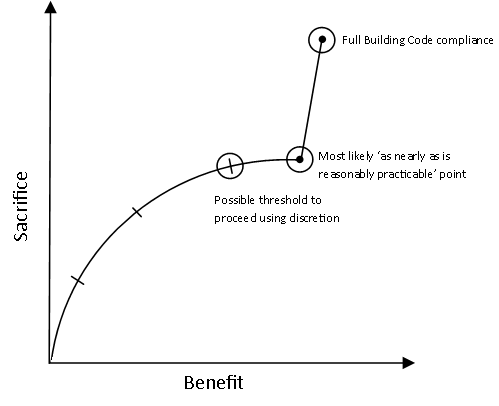Step 5: If required, territorial authorities consider if discretion applies to the application
There are certain criteria required for applicants seeking, and territorial authorities granting, discretion to proceed with an alteration that does not comply with the alterations requirements.
Territorial authorities have discretion to grant a building consent for a proposed alteration that does not comply
- 'as nearly as is reasonably practicable' (ANARP) for fire and accessibility, and/or
- to the same extent as before the alteration for other applicable Building Code provisions, eg structure.
This step only applies after the ANARP threshold has been established using steps 1–4, and the BCA has determined that the proposed alteration does not comply with the alterations requirements in either section 112 of the Building Act, or section 133AT of the Building Act for earthquake-prone buildings

Sections 112(2) and 133AT(3) of the Building Act give territorial authorities discretion to approve building consents for alterations where they consider that certain benefits of partial compliance will outweigh the detriment of not fully complying with all of those requirements.
This provision acknowledges that sometimes it is practical to prioritise some improvement over no improvement.
Applying this discretion in practice
There are strict conditions for applying this discretion.
This provision does not intend that achievable upgrades that have a significant impact would be waivered. It makes provisions for when compliance with the requirements of either section 112 or 133AT bring the viability of the proposed alteration into question altogether. Stopping the alteration proceeding would also prevent all the other possible improvements for fire and accessibility that have been identified.
The following criteria must be met:
Section 112(2) – Building is not earthquake prone
Criteria that must be met to grant a building consent using the discretionary power:
- if the building were required to comply with the relevant provisions of the Building Code, the alteration would not take place, and
- the alteration will result in improvements to attributes of the building that relate to means of escape from fire or access and facilities for persons with disabilities, and
- the improvements referred to above, outweigh any detriment that is likely to arise as a result of the building not complying with relevant provisions of the Building Code.
This provision ensures that improvements to fire or accessibility must be made during the course of the alteration.
The relevant provisions of the Building Code referred to are those relating to fire and accessibility, and any others the building is subject to, ie structure.
Section 133AT(3) – Building is earthquake prone
Criteria that must be met to grant a building consent using the discretionary power:
- the alteration includes the necessary seismic work, and
- if the building were required to comply with the specified provisions, it would be unduly onerous for the owner in the circumstances, and
- the permitted non-compliance is no more than is reasonably necessary for the objective of ensuring that the building or part is no longer earthquake prone, and
- after the alteration, the building will continue to comply with all relevant provisions to the same extent as before the alteration.
If compliance ANARP with the Building Code for fire and accessibility, or compliance to the same extent as before the alteration, would prevent the owner from being able to undertake the necessary structural work to make the building no longer earthquake-prone, the Building Act prioritises making the building no longer earthquake prone due to the associated life safety benefit.
The benefits of complying to a lesser extent must outweigh the detriment, ie the benefit of the building no longer being earthquake prone would be realised.
The relevant provisions of the Building Code referred to are those relating to fire and accessibility, and any others the building is subject to, ie structure.